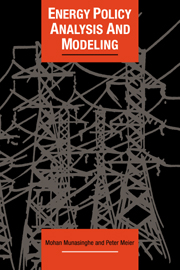Book contents
5 - Demand projection
Published online by Cambridge University Press: 05 March 2012
Summary
Estimates of future demands are a critical element of energy planning, at both the aggregate sectoral or national level and at the level of some specific fuel, such as electricity. Indeed, one of the most important reasons for making projections of future demand is the lead time required for supply projects. Since a typical baseload electric power plant takes between five and ten years to build, investment decisions must also be made with a five to ten year lead time. Similarly natural gas pipelines, LNG projects, and other capital-intensive energy supply projects invariably are predicated upon some estimate of future demand.
The heavy capital expenditures required to produce and consume energy is another major reason for improving the accuracy of demand forecasting. Errors tend to become expensive – if projections are too low, energy shortages may develop whose costs are usually a large multiple of the volume of energy not supplied, but if forecasts are too high, large amounts of capital with high opportunity costs might be uselessly tied up for long periods of time. Either of these consequences is far more costly to an economy than the resources that would have to be marshalled to undertake detailed and reliable demand studies that could help to avoid such errors.
The larger the time required for new energy supply installations, the greater is the need for forecast accuracy. For example, large thermal power plants may need four to six years to completion, but smaller gas turbines or diesel power plants can usually be commissioned on an emergency basis within one to two years.
- Type
- Chapter
- Information
- Energy Policy Analysis and Modelling , pp. 50 - 68Publisher: Cambridge University PressPrint publication year: 1993

